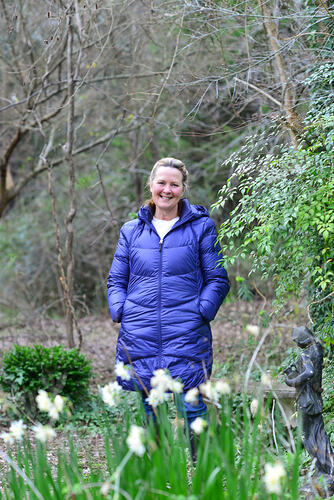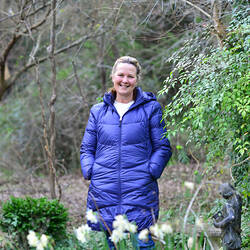Summary
This image is one of five photographs of Brialey Brightwell at Hoddles Creek taken by Tagen Baker on 6 August 2016 as part of The Invisible Farmer Project.
This particular image shows Karen Meeuwissen, Brialey's mother, standing among some flowers and trees on their property.
Brialey Brightwell began working at Nerrigundah Berries at the age of 22. As a family-owned and operated farm in Hoddles Creek, Brialey and her mother Karen Meeuwissen manage the production of a variety of berries, specialising in raspberries, blackberries, and boysenberries. Brialey speaks passionately about sustainability, land use, and irrigation farming practices.
The Invisible Farmer Project was the largest ever study of Australian women on the land, uncovering the histories and stories of Australian women in agriculture. It began as a pilot project (2015-2016) and evolved into a three year (2017-2020) nation-wide partnership between rural communities, academic, government and cultural organisations, funded by the Australian Research Council.
Description of Content
Woman wearing a purple jacket standing among some foliage.
Physical Description
Digital photograph
Significance
As a visiting research associate for Museum Victoria, and a PhD student in Utah State University's Department of Environment and Society, Tagen Baker had the opportunity to explore the diverse landscape of Victoria and interview and photograph women farmers as part of The Invisible Farmer Project-to learn from them about their histories, responses to climate change, and how they adapted their agricultural practices to sustain themselves and their families. Tagen wanted to know how their experiences have been similar or different to women in her home state of Idaho, USA. How have women been key agents of change embedded in their environments? How do women farmers provide unique perspectives and contributions to the futures of agriculture and to their communities?
As part of her research process, Tagen asked several women farmers if she could photograph them with an item of value. This item opened up a unique opportunity to communicate and learn about the farmers' lives. The item chosen was not only symbolic as a physical item of value, tangible and necessary, but a portal into a storytelling journey, a symbol of their rich and unique life experiences.
More Information
-
Collection Names
-
Collecting Areas
-
Photographer
-
Format
Digital file, Colour
-
Classification
-
Category
-
Discipline
-
Type of item
-
References
[Link 1] Last viewed: 6.4.17.
-
Keywords
Women Farmers, Women in Agriculture, Women's Issues, Women on Farms, Rural Women, Agriculture & Farming, Farmers

